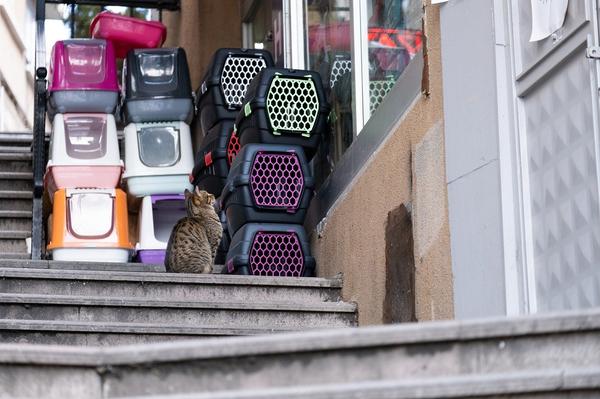How to Get Your Cat Into a Carrier (Without Fighting)

So you're determined to travel safely with your furry friend, huh?
You want to ensure that your cat stays safe and secure in that pesky carrier.
But let's be real for a second, we all know that getting a cat into a carrier can feel like trying to put a square peg into a round hole. 😩
It's frustrating, it's annoying, and it can make you feel like you're losing your mind.
Well, worry not my friend, because today I've got the ultimate guide for you.
Stick around and I'll show you how to conquer this challenge once and for all.
Ready to make your life a whole lot easier?
Let's do this!
How to Choose the Right Carrier for Your Cat
Choosing the right carrier for your cat is crucial for their comfort and safety during transport.

Here are some important considerations to keep in mind:
- Look for carriers with adjustable straps or handles to ensure a comfortable grip while carrying your cat. This will make it easier for you to transport them without straining yourself.
- Opt for a carrier that can be taken apart so you can remove the top half from the bottom. This feature comes in handy when your cat is anxious and reluctant to get inside. You can easily place them in or take them out without any hassle.
- Make sure to select a carrier that is appropriately sized for your cat. It should provide enough room for them to turn around comfortably and stretch out a bit.
- For added stability, you can use a towel to level out the carrier if it's placed on an inclined surface. This ensures that your cat won't slide around or feel uncomfortable during travel.
Discovering a carrier that matches your cat's requirements and is convenient for you can be achieved by taking into account these elements and following these practical suggestions always placing their comfort first. 😺
Introducing Your Cat to the Carrier
Encourage your cat to explore their carrier by using positive reinforcement.
Place treats or toys inside the carrier to entice them to venture inwards. To avoid frightening them, do not clip the top of the carrier while they are inside.
Instead, gently lift your cat out of the carrier and reassemble it elsewhere. This way, you encourage them to willingly enter the carrier again.

It's all about creating a safe and comfortable environment for your feline friend.
And finally, if you are facing challenges with introducing your cat to the carrier, such as anxiety or frustration, I have just the solution for you.
In my article, Older Cat Attacking New Kitten, I delve into the secrets of stopping an older cat from attacking a new kitten.
Getting Your Cat Used to the Carrier
Here's how you can help your cat feel at ease with the carrier:
- Train a few days before vet visits. Start early, don't rush.
- Gradually increase carrier time in short intervals. Take it slow and steady.
- Extend carrier time over multiple sessions. Little by little, make it longer.
- Leave carrier out as a resting place always. Make it accessible whenever.
- Line carrier with non-slip blanket for comfort. A cozy touch goes a long way.
- Use head-first or bottom-first technique to put your cat inside. Either works fine.
- Securely lock carrier door, cover it with towel or blanket. Keep it snug and safe.
- Let your cat see the carrier, let her explore it. Familiarize her with its presence.
- Spend time together inside the carrier. Be there for support and reassurance.
- After vet visits, clean carrier to remove strange smells. Make it fresh again.
- Consider moving carrier to an enclosed space, like a bathroom. Create familiarity.
With these steps, you can make your cat believe that the carrier is a secure and comfortable spot she can use regularly. ✨
Well, now that you've got your cat comfortable with the carrier, let's talk about some techniques for keeping them calm during travel and vet visits...
Minimizing Stress for Your Cat
Taking your cat to the vet can stress you and your furry friend.
But, with some preparation and helpful tips, you can make it less stressful.
Here are practical ways to reduce anxiety and make the process smoother:
- Play soothing pet music in the car to relax your cat during travel.
- If your cat gets nervous at the vet, gently lift them out by unclipping the carrier's top half or let the vet examine them inside the carrier.
- Before training your cat to be comfortable in the carrier, clean it with a biological solution to remove stress hormones.
- Use extra tools like pheromone sprays or soft music, and cover the carrier with a blanket to create a calm environment during car rides and office visits.
- Speak soothingly to your anxious cat during exams and let them sniff your fingers through the carrier door before opening it.
- Regular wellness checks are important for early illness detection and improving your cat's quality of life.
- In emergencies, putting a cat backwards in a carrier is an effective way to transport them safely.
- If your cat needs to stay in the carrier for longer periods during travel, offer them food and water.
- To keep your cat calm on the journey, cover their carrier with a blanket for security.
- Secure the carrier in the car by placing it on a flat surface, preferably the back seat, and use a seatbelt to tighten it, preventing movement during corners or sudden stops.
By adhering to these suggestions and establishing a serene ambiance, you can mitigate your feline's uneasiness and make veterinary appointments less demanding for both of you.
And it gets better...
We have even more tips and techniques to ensure a stress-free experience for both you and your cat when getting them into a carrier.
From the use of pheromone sprays to handling resistant cats with confidence, the next section will provide valuable information that you won't want to miss.
So, let's dive in and discover how to make this process even easier!
Tips for Handling a Resistant Cat

Here's how you handle a stubborn cat:
- Spray some special cat-smelling stuff by the carrier to keep them calm.
- Be confident and don't dilly-dally too much.
- Try different carriers till you find one your cat actually likes.
- Put one hand on their head and wrap your other arm around their body to keep 'em in place.
- Support 'em like you're cradling a football.
- Give 'em a gentle hold by grabbing the back of their neck.
- If needed, snuggle 'em up in a towel for extra safety.
- Keep your cool and be patient while dealing with all this drama. 🐱
Every cat is different, so tweak these tips to suit your furball's fancy.
Final Tips for Cat Carrier Success
Summary:
- Choose a carrier that can be taken apart for easier handling.
- Select a carrier that is the right size for your cat's comfort.
- Use a towel to level out the carrier if it's on a slant.
- Avoid clipping the top of the carrier while your cat is inside.
- Gently lift your cat out of the carrier and reassemble it elsewhere.
- Leave the carrier out permanently as a resting place and line it with a familiar blanket.
- Use the head first or bottom first technique to put your cat in the carrier.
- Lock the door securely and cover it with a blanket or towel for added comfort.
- Clean the carrier after a vet visit to remove unfamiliar smells.
- Keep the carrier visible and gradually acclimate your cat to it.
- Unclip the top half of the carrier during vet visits for easier handling.
- Clean the carrier with a biological solution to remove stress hormones.
- Use tools like pheromone sprays and soft music to calm your cat during trips.
- Talk soothingly to your cat and let her sniff your fingers before opening the carrier.
- Regular wellness checks are important for early illness detection.
And that wraps up today's article.
If you wish to read more of my useful articles, I recommend you check out some of these: Why Does My Cat Lay on Me and Purr, How to Train Your Cat to Sit, How Do Mother Cats Discipline Their Kittens, Why Is My Cat Obsessed With My Face, and Why Does My Cat Walk on Me
Talk soon,
-Sarah Davis